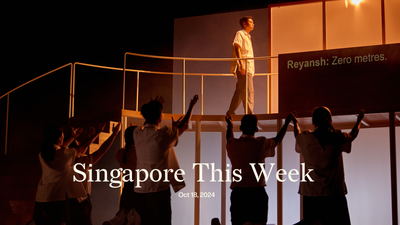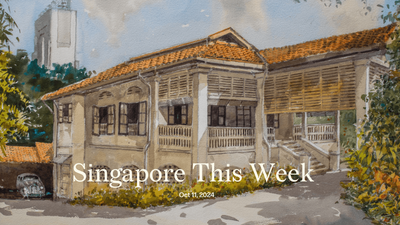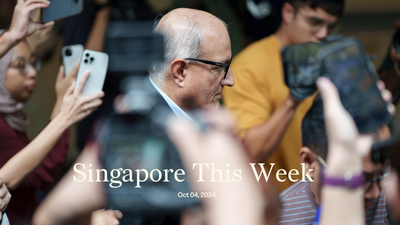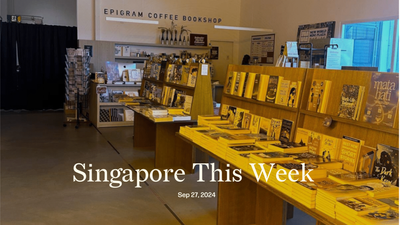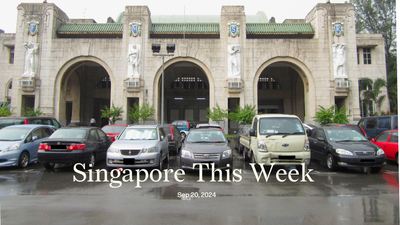Politics: TODAY, a tongue-tied CEO, and a trippy getai show
The Singapore government’s uncertainty in dealing with basic questions around gay rights was underscored by a bizarre exchange between the National Arts Council (NAC) and TODAY. It began with an impromptu interview last Friday on the sidelines of the 10th anniversary of the Nanyang Technological University Centre for Contemporary Art (NTU CCA) Singapore. A TODAY reporter asked Low Eng Teong, NAC’s CEO, about the staging of “Queer-tai”, an LGBTQ interpretation of a traditional getai show: out with the Hokkien/Mandarin singers, in with a drag queen playing trombone. The next day, TODAY published an article, “LGBTQ-themed arts performances in public spaces in line with the times: National Arts Council chief”, which irked NAC. It got TODAY to edit the headline and then published its own clarification, in which it accused TODAY of quoting Low out of context in a misleading article. Not serious enough to warrant a POFMA, apparently. If NAC thought it was playing nice, TODAY was having none of it. A day later, it released the transcript of the interview, which showed Low fumbling to answer straightforward questions about LGBTQ-themed work in “mainstream and institutional spaces”, before being saved by an unnamed NTU representative. They both attempted to deflect the question to Ute Meta Bauer, CCA’s German head. Is the NAC’s CEO uncomfortable answering simple questions about art in public spaces? Would Bauer have been engaging in “foreign interference” if she had commented on gay rights? All this is arguably a symptom of the wishy-washy way Singapore has made progress on gay rights. Civil servants may be worried about annoying the religious right, as well as their bosses—Low, like most previous NAC heads, is a highly paid career bureaucrat doing his rounds. NTU said that given sensitivities around a performer in drag, “...it should not have been staged as a public event.” The whole episode will likely mean less tolerance in establishment events for anything deemed queer. It also highlights a trend in media diversity: the MSM is less and less monolithic. The Straits Times (ST) would probably not exude such public bravado towards a statutory board. The drag queen, it should be noted, was blowing out a National Day number. Even patriotism couldn’t save them.
Society: Singapore’s ‘high-quality, authoritative and influential mainstream media’
At Chinese-language broadsheet Lianhe Zaobao’s centennial gala dinner last Friday, Lee Hsien Loong, Singapore’s prime minister, highlighted the importance of having “high-quality, authoritative and influential mainstream media”. Lee explained that this was why the government would continue to support SPH Media Trust (SMT), Zaobao’s parent company. Lee’s unreserved validation of Zaobao comes two months after the government was miffed by “In Singapore, loud echoes of Beijing’s positions generate anxiety”, an investigative piece by Shibani Mahtani of The Washington Post (WaPo), in which she claimed that Zaobao “routinely echoes some of Beijing’s most strident falsehoods.” Zaobao’s editor Goh Sin Teck, who’s quoted in the piece, suggested that the US paper had looked at the issue with “its own pre-established perspective and agenda” and “selectively left out some facts while intentionally highlighting others to paint a negative image.” Peter Ong, Zaobao’s associate editor, also argued that the Western media have entered “a mode of cognitive warfare”, and are constantly “on a witch hunt.” In a letter to the US paper, Lui Tuck Yew, Singapore’s ambassador to the US, who formerly held the same role in China, wrote: “Singapore conducts its foreign policy based on our own interests. We do not pick sides but uphold consistent principles.” Singapore, like many other South-east Asian countries, is eager to maintain its non-alignment in what some term the “21st century’s Cold War”. Yet, Zaobao is increasingly dependent on the Chinese market, with over 4m monthly readers there, more than twice the number of Singaporeans whose primary home language is Mandarin, according to census data. And Singaporeans have some of the most favourable views of China anywhere in the world. Commercial pressures may be influencing Zaobao, as WaPo suggested. Meanwhile, the notion that WaPo’s piece was Western propaganda is undermined by the fact that Mahtani is Singaporean, something not mentioned by Goh, Ong, and Lui in their responses. What’s her view on all this? She’ll be speaking alongside Sue-Lin Wong of The Economist and Karishma Vaswani of Bloomberg at our next “Jom Cakap”, on October 16th. Purchase your tickets now.
Society: ‘Eh, wanna go VB [vape break]?’
Buttermilk pudding, red bean, tie guan yin and strawberry milk are just some of the vape flavours Singaporean youth are into. Some 800 were referred to the Health Sciences Authority (HSA) for vaping offences last year, compared to fewer than 50 in 2018-19. Compared to cigarettes, vapes are, for students, more flavourful; cheaper (a disposable vape costs S$30 and can last roughly 5,000 puffs, compared to a S$14 pack of 20 cigarettes); more discreet, since the sweet-smelling mist is less detectable in school toilets and dorm rooms; and supposedly less harmful. (There’s more expert consensus around the effects of smoking than of vaping.) In dormitories of local universities, some students are not only vaping but dealing. “For about seven months, I sold these vaporisers as it was a good side income,” one National University of Singapore student told ST, which also ensured that her “own stash” wouldn’t run out. In China, more youth are taking up vaping despite a ban on sales to minors, and over 14 percent of American high school students were found in 2022 to smoke e-cigarettes, even after a slew of lawsuits against Juul, for its predatory marketing. (Juul’s valuation dropped 95 percent from 2018 to 2022.) Some say social media is to blame. A study by Australia’s Curtin University found that of the TikTok videos related to e-cigarettes, 98 percent portrayed them positively. Even though the purchase, possession and use of vapes have been outlawed in Singapore since 2018, it’s not vigilantly policed. Every evening, users puff openly at bars around town. (Almost 5,000 were caught island-wide last year, says HSA.) Like other countries, Singapore must weigh the perennial e-cigarette trade-off: as a possible cessation tool for older smokers versus the risk of youths getting addicted. Yip Hon Weng, a member of Parliament, suggested random checks and a system of incentivised tip-offs in hostels by university staff and students. (Oh, how we love getting people to rat on each other.) Whether such forceful interventions will actually curb vaping culture or push it further underground is uncertain.
History weekly by Faris Joraimi
A beautiful map produced by the famous Indonesian painter Raden Saleh (1811-1880) was recently discovered at the Museum Bronbeek in the Netherlands. Entitled “Plan der Negory Tjeandjor”, it shows Cianjur, a town in a mountainous cultural region of west Java called Parahyangan (or Priangan), which means “abode of the gods” (hyang) in Sundanese. About two hours’ drive south of Jakarta today, Cianjur was the political centre of Parahyangan in colonial times. The map dates to 1829, and entered the Bronbeek’s collection sometime before 1997. It was found during a research visit by the art historian Dr Marie-Odette Scalliet, when the museum staff looked up any and all available items related to Raden Saleh. The painter, who is not known for cartographic work, had signed his name on the bottom-right of the map, which was pen-drawn and partly coloured. At the time, Raden Saleh had concluded his apprenticeship in Bogor under the Belgian landscape painter Antoine Payen, who was himself a mapmaker for the Dutch governor of Java. Those skills were likely transferred to Saleh, who left Java for Europe the same year the Cianjur map was made. He only returned 20 years later, by then a master of Western painting and the toast of progressive German intellectuals. What I love about this map is that it contains elegant penmanship in both Dutch and Javanese, the latter in traditional hanacaraka script, reflecting Saleh’s bilingual upbringing as a European-educated Javanese aristocrat. Another point of interest is the reference to Cianjur as a “negory” or negeri, the historical term for “town” or “city” in Malay, the administrative language of colonial Indonesia. We don’t use negeri the same way any more, as the term now applies to territorial states, usually smaller units within a large country (negara). In modern Malay and Indonesian, the words kota or bandar are used for cities instead. Raden Saleh is often considered the first “modern” Indonesian artist, and his works are displayed at the National Gallery Singapore.
Arts: Conference in the morning, Unconference in the afternoon
The Performing Arts x Tech Conference-Unconference, organised by NAC in collaboration with Esplanade—Theatres on the Bay, takes place on Saturday, October 7th. The event is split into two parts. During the Conference, attendees can expect to hear from local and international performance-makers and creative technologists, such as Toby Coffey (National Theatre, UK), Clarence Ng and Mitsuru Tokisato (Yamaguchi Center for Arts and Media), Ho Tzu Nyen, and bani haykal, across two panels that focus on “Ways of Making” and “Ways of Framing”. The second half of the event, the Unconference, will feature presentations and breakout discussions by the Performing Arts x Tech Lab Artists, who are exploring the possibilities of algorithmic dance systems (Dapheny Chen & Serial Co); multi-disciplinary theatrical experiences (Issy x Cher); machines as live performers (Feelers); interactive technology in immersive performances (Alina Ling and Andy Lim); artificial intelligence in storytelling (Kamini Ramachandran, Syafiq Halid, Chen Enjiao); and technologies that allow dancers to control and manipulate sound, lights and visuals (James Lye). Attendees will also have the opportunity to propose additional sessions or topics for discussion during the Open Space Breakout Sessions. Tickets are still available for the half-day Conference.
Arts: Archifest in Gelam
The 17th edition of Singapore Archifest, titled “Interim: Acts of Adaptation”, finds itself in Kampong Gelam, where the festival’s traditional pavilion format is reimagined as six “AF Installations”. These installations offer a starting point to find out more about Kampong Gelam, an area of historical and contemporary importance to Singapore’s Malay community. But they struggle to offer more in-depth interrogations of the “interim”, or the neighbourhood itself, which is a challenging one to situate work in; it is so vibrant and complex, that the works can get lost. A night wander around the neighbourhood found “Dulang Dulang” by Syafiq Jubri and Syazwan Hanif—an installation in the form of a communal table that seeks to transform a parking lot into a gathering space—surrounded by tables and chairs from a nearby restaurant. “Dulang Dulang” remained unused, but some tables from the actual restaurant were occupied. Elsewhere, Faiz bin Zohri’s “Scaffold Bridge Over Fence”, does precisely what its title suggests, offering wanderers a way into an empty, green plot of land that is usually fenced off. Faiz provides us an opportunity to reclaim the lost space that was once Pondok Jawa, a lodging and community space for the Javenese community until its demolition in 2003. One wonders: would anyone wander off the paved pathway onto the grass to climb the scaffolded bridge to nowhere? These installations have to be activated in order to reveal their full potential. In offering a table and chairs, Syafiq and Syazwan present a gathering space, just as the restaurant does. But Kampong Gelam has its own ways of working around what is lost and what remains. On the way out, one might notice remnants of an old building along a green patch. Near the parking lot, two men sat on their own chairs, drinking teh, with a table between them, having their own gathering.
Tech: SGX’s first SPAC acquisition?
Vertex Technology Acquisition Corporation (VTAC), the SPAC (special purpose acquisition companies) listed on the Singapore Exchange (SGX), has announced its planned acquisition of 17LIVE, a leading live social entertainment platform based in Taiwan. Pending approval from SGX and VTAC’s shareholders (including Temasek), the proposed merger will value the joint entity at up to S$1.16bn. This will be a pivotal moment for the regional start-up ecosystem, as it would mark the first successful SPAC acquisition on the SGX, possibly paving the way for other regional start-ups to go public through this method. The financial attractiveness of 17LIVE is clear from its impressive revenue of US$363.7m (S$497m) and adjusted EBITDA of US$15.8 m (S$21.6m) in 2022, as stated by VTAC. Coupled with the launch of new business initiatives like V-LIVER, a virtual live streaming service, in-app games, and live commerce, the platform is well-positioned for continued growth. The terms of the deal include VTAC acquiring the entire issued and paid-up share capital of 17LIVE for almost S$925.1m. 17LIVE can trace its roots to Vertex Ventures’s 2014 investment in dating app Paktor Group. In 2016, Paktor merged with livestreaming firm 17 Media to form M17 Entertainment (later 17LIVE). Its complex history includes a cancelled public listing in 2018 due to share settlement issues. This potential merger with VTAC could mark a significant turnaround for the platform, ultimately facilitating its entry into the public market.
Tech: Capital for good
A crop of impact start-ups, which place a premium on social and environmental objectives, is emerging in Singapore. TreeDots, which aims to reduce food waste by connecting suppliers to businesses to sell excess or imperfect food supplies that are still of decent quality. There are also several mental health start-ups aiming to democratise access to mental health services such as Intellect and Thoughtfull. But while venture capital funding has been on the rise over the last few years, their sector receives little of it. After all, venture capitalists are often seeking out opportunities that have high risk and high reward—financially. To enhance the support for impact start-ups, Singapore’s Temasek Trust and DBS Foundation are launching Co-Axis, a digital platform designed to pair impact start-ups with potential investors. The platform helps impact start-ups pool resources from private investors like venture capitalists, private equity firms, public funds, and philanthropists through different financial instruments, such as donations, recoverable grants and blended finance structures. In the longer term, the platform will include other instruments such as concessional securities. According to a 2023 report from the Global Impact Investing Network, Asia accounts for only less than 25 percent of the burgeoning global impact market, presently appraised at over US$1tn (S$1.4tn). With the beta version of Co-Axis slated for launch in the first half of 2024, hopefully the platform will soon enable social innovation to receive the capital it needs to launch and scale impact, while promoting a culture of responsible investing.
Correction: an earlier version of our politics blurb said that the MSM remains untouched by POFMA. But in 2020, the government issued CNA a POFMA directive. Sorry.
If you enjoy Jom’s work, do get a paid subscription today to support independent journalism in Singapore.


